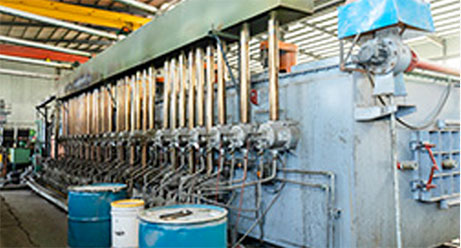

astm a325 bolts
Dec . 03, 2024 15:39 Back to list
astm a325 bolts
Understanding ASTM A325 Bolts Specifications and Applications
In the realm of construction and engineering, the reliable fastening of components is crucial for structural integrity and safety. One of the most widely recognized standards for bolts used in steel constructions is ASTM A325. Established by the American Society for Testing and Materials (ASTM), this specification outlines the requirements for high-strength bolts that are often used in bolted connections, particularly for structural steel applications.
Composition and Properties
ASTM A325 bolts are typically made from carbon steel, and they may be heat-treated to achieve the desired mechanical properties. The primary grades of A325 bolts are Grade A and Grade B, with Grade A bolted assemblies requiring a specific level of hexagonal head design and configuration, while Grade B bolts may have smooth or serrated bearing surfaces. Both grades have distinctive characteristics that dictate their applications, often influenced by their strength and ability to resist shear and tensile loads.
The tensile strength of A325 bolts is a critical factor. According to ASTM specifications, these bolts have a minimum tensile strength of 120 ksi (kilopounds per square inch), which translates to a high level of resilience in holding structural elements together. Additionally, A325 bolts are designed to be installed with a torque specification to ensure the proper tension in the joint, which is paramount for achieving optimal load distribution and preventing joint failure.
Coatings and Corrosion Resistance
Given their applications in outdoor and potentially corrosive environments, ASTM A325 bolts can come with various protective coatings. Common types of coatings include hot-dip galvanizing and zinc plating, which enhance the corrosion resistance of the bolts. Hot-dip galvanizing involves dipping the bolts in molten zinc, creating a robust protective layer that withstands environmental factors such as moisture and salt, making them ideal for bridges, highways, and marine structures.
astm a325 bolts

When using A325 bolts, it is crucial to assess the environmental conditions of the project site to select the appropriate coating. This is vital for ensuring the longevity of the connections and maintaining structural integrity over time.
Applications
ASTM A325 bolts are predominantly used in the construction of steel structures, including bridges, buildings, and other infrastructure projects. Their high tensile strength makes them suitable for load-bearing applications where safety and durability are paramount, such as in tension and shear connections in steel frames. They are often employed in conjunction with A325 nuts and washers, which are designed to complement the bolts and ensure a secure and durable fastening.
Moreover, these bolts are utilized in various industrial applications, including petrochemical plants, power generation facilities, and wind farms, where heavy machinery requires robust assembly. The significant performance characteristics of ASTM A325 bolts under dynamic and static loads make them a favored choice among engineers and project managers.
Conclusion
In summary, ASTM A325 bolts are integral components in both structural and industrial applications. Their strength, versatility, and corrosion resistance enable them to endure challenging environments and loads. Adhering strictly to ASTM standards helps ensure that engineers and contractors can deliver safe and durable structures. Understanding the specifications related to ASTM A325 bolts is essential for making informed decisions about project requirements and ensuring long-lasting, reliable connections in various engineering applications. As we progress in construction technology and materials science, the importance of standards like ASTM A325 remains crucial in fostering safety and reliability in our built environment.
Latest news
-
High-Strength Hot Dip Galvanized Bolts - Hebei Longze | Corrosion Resistance, Customization
NewsJul.30,2025
-
Hot Dip Galvanized Bolts-Hebei Longze|Corrosion Resistance&High Strength
NewsJul.30,2025
-
High-Strength Hot-Dip Galvanized Bolts-Hebei Longze|Corrosion Resistance&High Strength
NewsJul.30,2025
-
Hot Dip Galvanized Bolts-Hebei Longze|Corrosion Resistance&High Strength
NewsJul.30,2025
-
Hot Dip Galvanized Bolts - Hebei Longze | Corrosion Resistance, High Strength
NewsJul.30,2025
-
High-Strength Hot Dip Galvanized Bolts-Hebei Longze|Corrosion Resistance, Grade 8.8
NewsJul.30,2025

